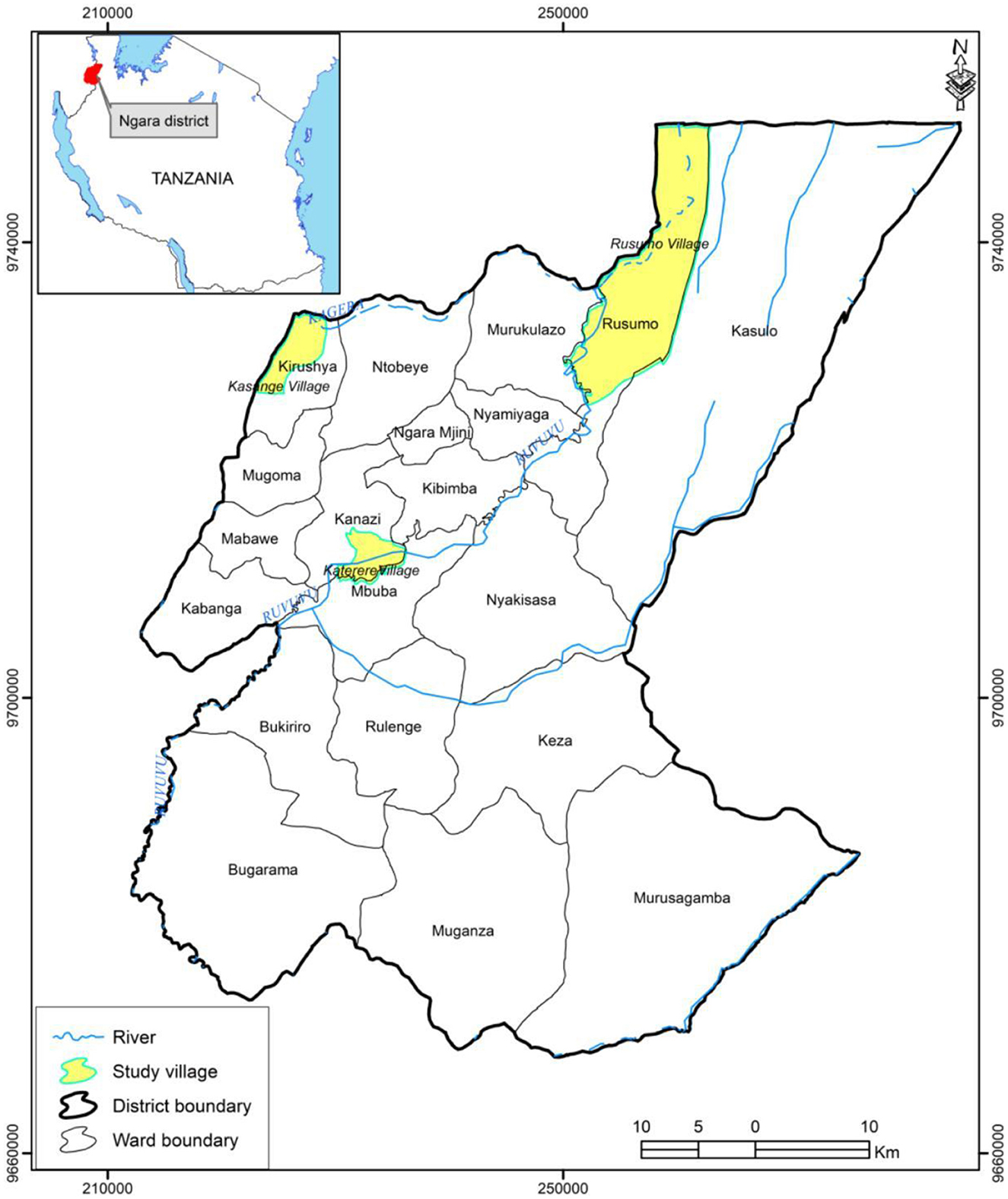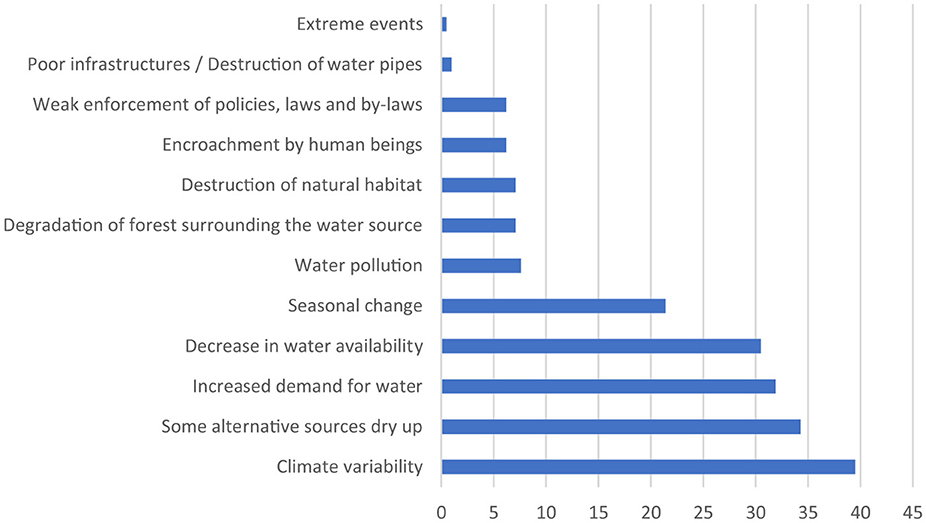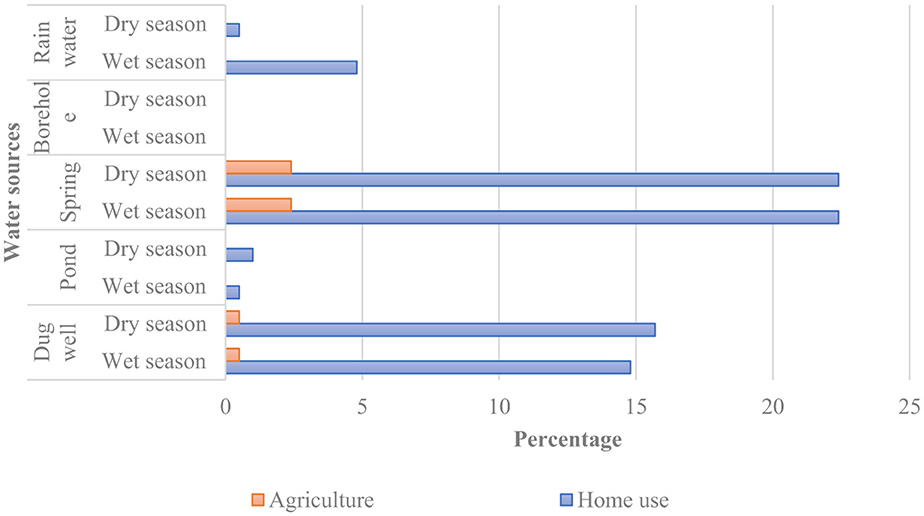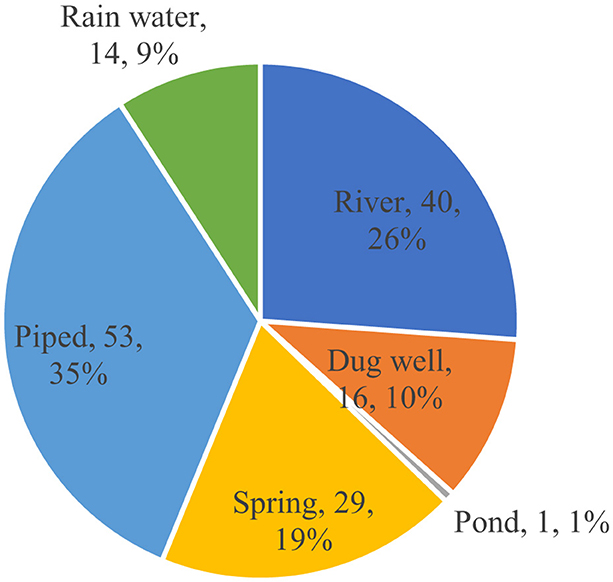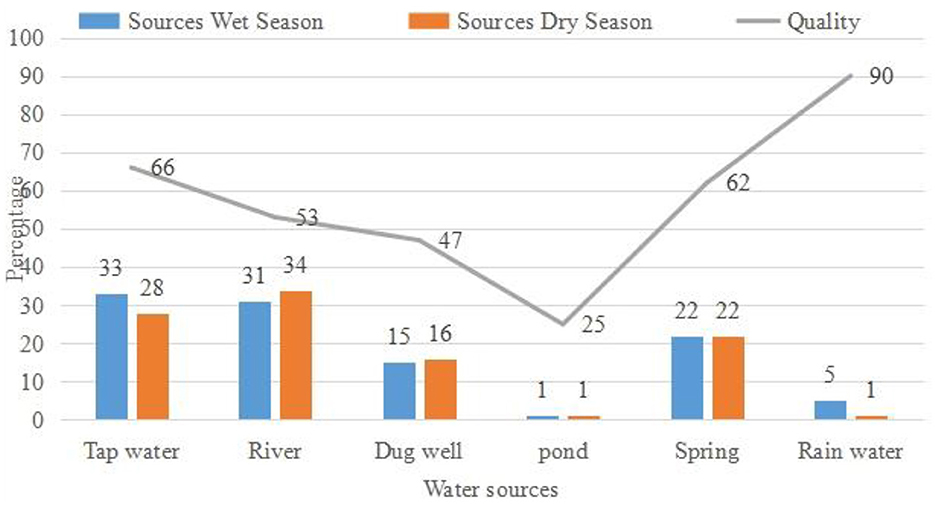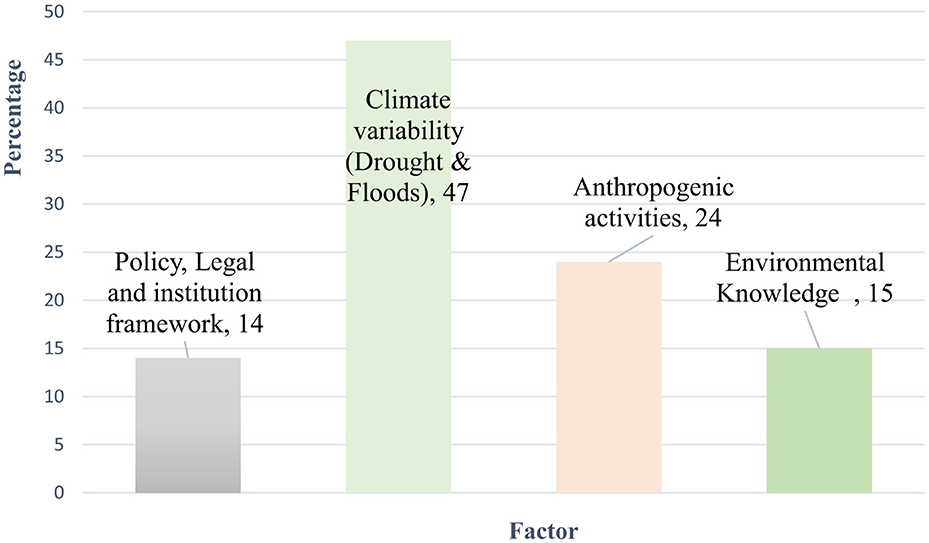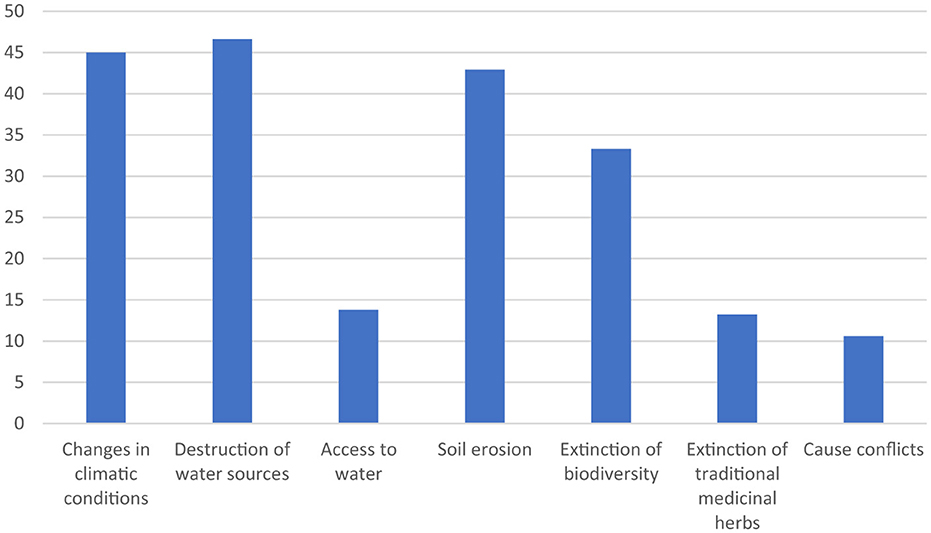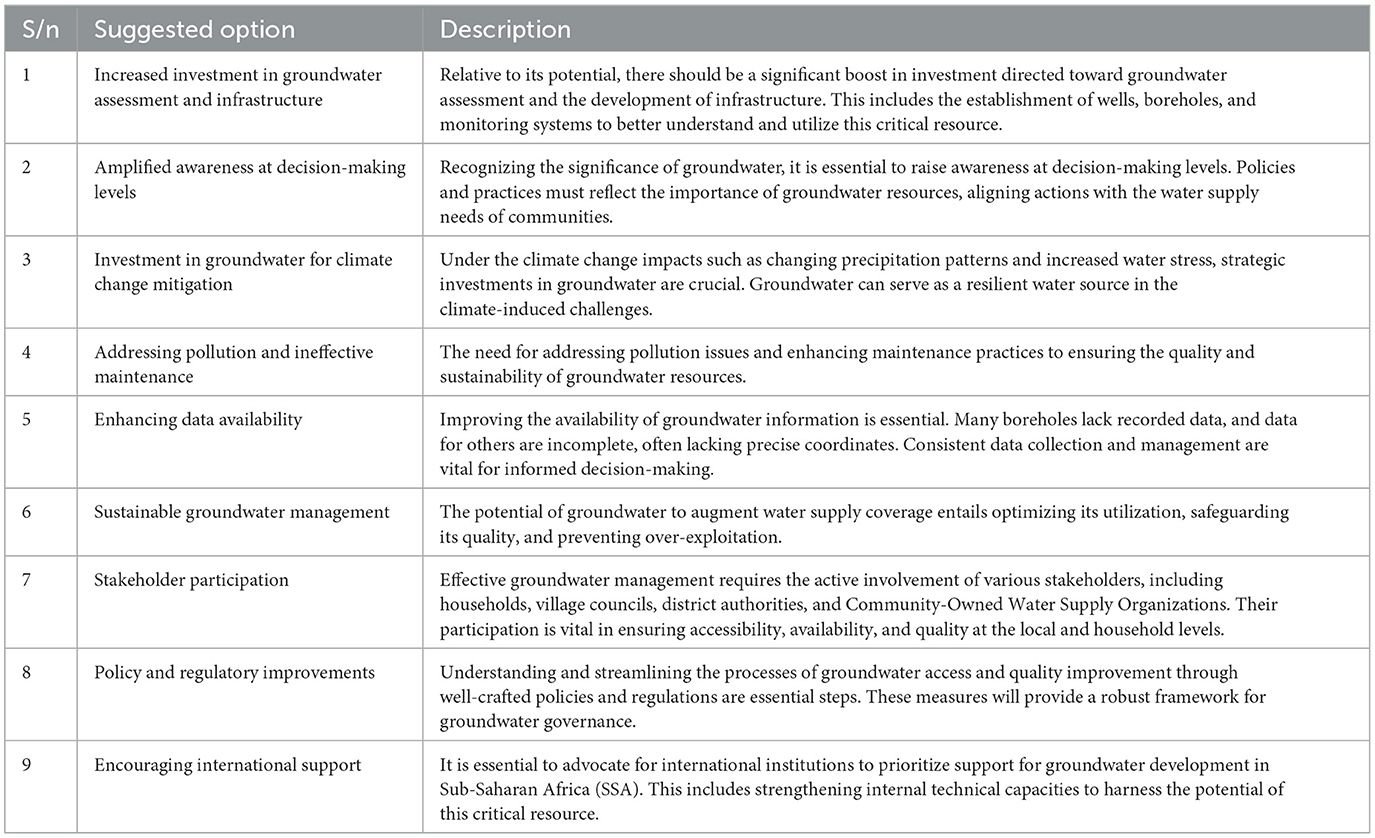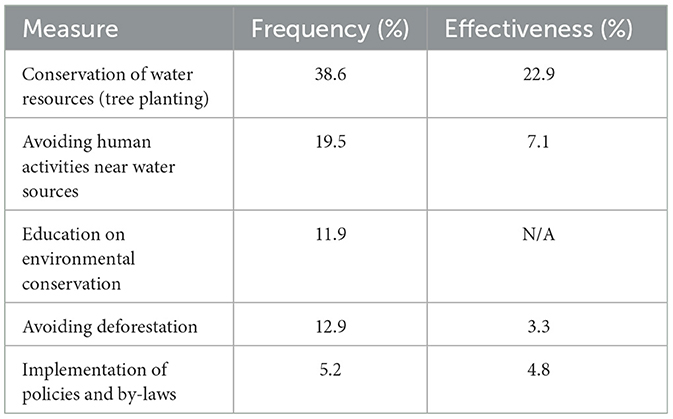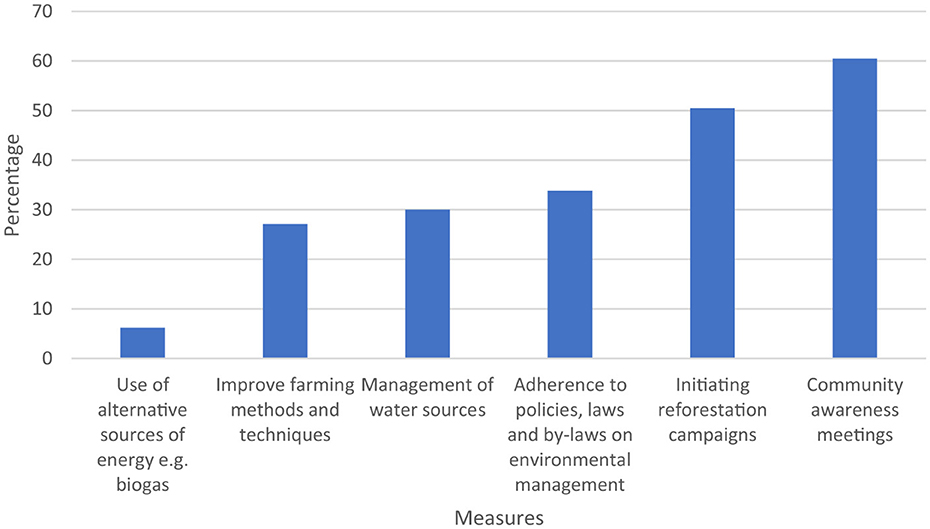- 1Institute of Resource Assessment, University of Dar es Salaam, Dar es Salaam, Tanzania
- 2Faculty of Science and Education, University of Iringa, Iringa, Tanzania
Groundwater is a crucial resource for global populations and economies, particularly in developing countries where water scarcity is a growing concern. Serving as a primary water supply for approximately two billion people, it accounts for 42% of irrigation water and contributes to around 40% of global food production. However, groundwater sources still need to be explored due to differentiated water access, inadequate knowledge, poor technology, socio-economic challenges, and increasing pollution. This study focuses on the underutilized groundwater sources in the North West Highlands of Tanzania, where governance information is sparse in the existing literature. The study employed a mixed-methods approach, utilizing key informant interviews, household questionnaires, focus group discussions, direct observations, and secondary data sources. Results revealed that farming remains the dominant livelihood activity, with significant reliance on diverse water sources, yet water quality and availability are declining exacerbating the challenges. Despite ground water potential, disparities in knowledge, infrastructure development, technological capacity, and enforcement abilities significantly influenced its access. Concurrently, differing priorities among government actors hinder the optimal exploitation of groundwater to improve water access, exacerbating issues of water rights and conflicts. Most households access groundwater through inexpensive, simple technologies requiring minimal financial investment. The challenges such as declining water tables, well deepening and enlargement costs, limited financial resources, inadequate technology, and weak governance impede effective utilization. The study concludes that although groundwater utilization is currently low, it holds substantial potential for irrigation and improving water resilience, thereby reducing water rights conflicts. Under the changing climate and increasing demands, groundwater remains a promising resource for irrigation, enhancing water resilience and pursuit of Sustainable Development Goals (SDGs). Recommendations emphasize the need for understanding of water processes, improved access and quality to mitigate water conflicts. The findings are useful in informing policy-making, planners and guiding interventions aimed at enhancing the resilience of rural communities in the face of climate variability and water scarcity.
1 Introduction
Groundwater stands as a lifeline for a substantial portion of the global population and is of paramount importance to the economies of many nations, particularly those grappling with water scarcity and stress. This precious resource serves as the primary source of drinking water for approximately two billion people and is responsible for supplying 42% of the world's irrigation water, contributing significantly to global food production (40%) (Braune and Xu, 2010; Lapworth et al., 2022). In recent years, groundwater resources have gained recognition as a potential solution to irrigation and domestic water needs in rural and urban areas. While groundwater use in Africa has been historically limited (Komakech and de Bont, 2018), it is on the rise due to factors such as the over-allocation of surface water, population growth, and advancements in technology, including the development of solar energy and the availability of affordable petrol pumps (Braune and Xu, 2010; Cobbing and Hiller, 2019; International Water Institute, 2021). However, these developments have also given rise to localized overexploitation of groundwater resources, particularly in urban areas, leading to declining groundwater levels and deteriorating water quality (Hoogesteger and Wester, 2015). Consequently, it is imperative that land use planners take proactive steps to ensure the sustainability and protection of groundwater resources.
Groundwater plays a crucial role in water supply systems across sub-Saharan Africa, especially in regions where surface water resources are limited or unreliable. It is a critical water source in rural areas, serving as a vital resource for drinking water, agriculture, and other economic activities. According to Braune and Xu (2010), groundwater supports a significant portion of the population in Africa, contributing to agriculture, domestic use, and industrial processes. Despite its importance, groundwater resources remain underutilized in many areas due to inadequate exploration and inefficient management practices. To fully utilization of ground water, a concerted effort is required to address the challenges, harness the its potential, and ensure sustainable management (Cobbing and Hiller, 2019; Duguma et al., 2020; Kashaigili, 2022). Nonetheless, understanding of groundwater recharge areas and their stability under changing environmental conditions remains limited (Kashaigili, 2022). Moreover, the interplay between climate change, irrigation, vegetation, and river discharges in affecting groundwater recharge processes remains inadequately explored (Said et al., 2019; Nijhawan and Howard, 2022). Access to groundwater is not uniformly distributed, with various factors, including physical location and social relations, determining an individual's capability to access this resource (Komakech and de Bont, 2018). Policy and institutional frameworks also contribute to inequitable access to groundwater, particularly in regions with uneven water distribution (Komakech and de Bont, 2018).
Tanzania, like many other countries in sub-Saharan Africa, faces the challenge of managing its transboundary water resources effectively (Gwambene, 2017). Komakech and de Bont (2018) highlight that inequitable access to groundwater and its over-exploitation in Tanzania has led to challenges in sustainable management. This issue is exacerbated by the lack of adequate governance structures, resulting in conflicts between different water users, particularly in rural areas. Furthermore, as Cassidy-Neumiller et al. (2024) note, cross-border water management in Africa often encounters political and socio-economic challenges that hinder equitable water sharing. In the Kagera Sub-Basin, agriculture and livestock farming are the primary livelihoods, and water demand is continually rising. However, due to the reliance on surface water sources such as rivers, ponds and lakes, communities face increasing water stress, especially during dry seasons (Gwambene, 2017; Gudaga et al., 2021). This has heightened competition for water, leading to tensions among neighboring communities. As McCaffrey et al. (2017) and Richards (2019) observe, water conflicts are common in areas where water governance is weak, and resource allocation does not consider the needs of all stakeholders equitably.
Groundwater offers a viable solution to alleviate water stress and support livelihoods in water-scarce regions. Cobbing and Hiller (2019) argue that groundwater remains a “sleeping giant” in sub-Saharan Africa, with untapped potential that, if realized, could transform the region's water security. In Tanzania, there are vast reserves of groundwater that have not been fully explored or utilized, particularly in the Kagera Sub-Basin. As Kashaigili (2022) points out, sustainable groundwater extraction could not only reduce water scarcity but also provide a buffer against climate change impacts, ensuring a more reliable water supply throughout the year.
Despite the recognition of groundwater's potential, its underutilization highlights a critical gap in water resource management. The main problem lies in the limited exploration and sustainable management of these resources. This study seeks to address this gap by exploring the untapped groundwater resources in the region and assessing their potential to support livelihoods and reduce water-related conflicts. This study seeks to enhance access to groundwater in the Kagera Sub-Basin of Tanzania, where water scarcity has been a growing concern.
It examines the socio-economic benefits of enhanced water access reducing conflict among water users, and improving livelihoods in the Sub-Basin. This study contributes to the understanding a diverse water sources and offer practical solutions for improving water security and mitigating conflicts in the Kagera Sub-Basin. It provides understandings into how underutilized water sources can be harnessed for sustainable development, particularly in regions experiencing water scarcity.
2 Methodology
2.1 Study area
The study was conducted in the Kagera Sub-Basin, which is a transboundary catchment and aquifer shared between Burundi, Rwanda, Uganda, and Tanzania. Specifically, the study conducted within Ngara District, located between longitude 30° 15′E and latitude 2° 10′ to 3° 0′S. Ngara District is one of eight districts in the Kagera Region and shares borders with Rwanda to the north, Burundi to the west and south, and Biharamulo District to the east. The research focused on three villages in the District including Katelele (upland), Kasange (midland), and Rusumo (downstream). Ngara District is strategically situated due to its proximity to neighboring countries Rwanda and Burundi, which influences cross-border interactions, including resource use and management (Figure 1). The topography of the district is characterized by dissected plateaus, with hills and valleys shaped by historical erosion. Several key rivers traverse the district, including the Kagera River, which marks the north-western boundary with Burundi and Rwanda, and the Ruvubu River, which flows along the southern border and converges with the Kagera River. This complex hydrology creates diverse water access challenges and opportunities within the district. Land use in the region includes upland agriculture, wetland agriculture, silviculture, game reserves, and livestock farming, with natural vegetation primarily consisting of riverine forests, grasslands, and wooded areas.
2.2 Research approach
The methodology combined both qualitative and quantitative data collection and analysis techniques to ensure a holistic understanding of groundwater access, utilization, and governance challenges in the Kagera Sub-Basin. The approach allowed for triangulation of data from different sources, providing a strong basis for drawing conclusions and making recommendations. The methods used included Household Questionnaire Surveys, Key Informant Interviews, Focus Group Discussions (FGDs), and Field Observations. A literature review was also conducted, drawing from a variety of sources such as government reports, academic papers, and relevant policy documents, providing context and supporting the analysis of the field data.
2.3 Sampling procedure and sample size
The study utilized a combination of purposive and random sampling techniques. Initially, the District and three specific wards and villages in the Kagera sub-basin were purposively selected based on their relevance to the research objectives. A simple random sampling method was employed to determine households and key informants. From the target population, 210 households and 20 key informants (Including Basin Officers, local Government offices at Regional, District, Wards, villages, NGOs, and prominent/aged people) were purposely and randomly selected to participate in the study. This approach ensured that each household and key informant had an equal chance of being included in the sample, providing a representative cross-section of the population.
Moreover, the research team conducted Focus Group Discussions (FGDs) to collect insights from the local community. The team purposefully selected participants for the FGDs in each village to ensure a comprehensive representation of socio-economic groups. Specifically, the team organized three FGDs in each village, categorizing them as Women's, Men's, and Village Government groups. This approach aimed to capture diverse perspectives and experiences from various community segments. The purposive selection of FGD participants allowed for a deeper understanding of community views and experiences related to water resources, land management, and livelihood sustainability.
2.4 Data collection method
2.4.1 Household questionnaire surveys
The Household Questionnaire Surveys were designed to collect quantitative data from households in the three target villages Katelele, Kasange, and Rusumo. A total of 210 households were surveyed, with questionnaires focusing on water sources, water uses and management, and challenges related to groundwater access. The respondents were primarily heads of households, but in their absence, another knowledgeable household member was interviewed. The surveys aimed to quantify the extent of groundwater utilization, identify the main barriers to access, and explore household-level strategies for managing water resources.
2.4.2 Key informant interviews
Key Informant Interviews (KIIs) were conducted with individuals who hold specialized knowledge and influence regarding water management in the study area. These included local government officials at the village, ward, and district levels, members of the Water User Association (WUA), representatives from environment-related organizations, water basin authorities, and officials from the regional office. The interviews provided in-depth insights into policy implementation, institutional challenges, and the role of governance in managing groundwater resources. This method helped contextualize the data collected from households and provided expert perspectives on water governance and access.
2.4.3 Focus group discussions
Nine Focus Group Discussions (FGDs) were organized to gather qualitative data on community-level perceptions and experiences with groundwater use. Each village had three FGDs, with separate discussions for women, men, and local government representatives, with 8 to 14 participants per group. The FGDs enabled a deeper understanding of the social dynamics influencing water access and highlighted local attitudes toward groundwater management. Through these discussions, critical issues such as gender-based water access disparities, conflict resolution, and community-led initiatives for water source management were explored.
2.4.4 Field observations
Field observations were conducted to directly assess physical groundwater infrastructure, well conditions, the state of water sources, and livelihood activities in the study area. The assessment also examined the management practices employed at water points and the quality of the infrastructure in place. This method allowed for the validation of data from interviews and surveys and provided real-time evidence on groundwater availability and challenges.
2.5 Data organization and analysis
The data collected was systematically organized for analysis. Quantitative data from the Household Questionnaire Surveys were analyzed using SPSS 20 software, focusing on descriptive statistics, such as frequencies, percentages, and cross-tabulations, to identify trends and patterns in groundwater access and use. This analysis enabled the identification of key variables influencing household water source preferences and challenges. Qualitative data from KIIs, FGDs, and field observations were analyzed using thematic analysis. This involved identifying recurring themes, patterns, and narratives within the responses, with particular attention to issues of governance, technology, infrastructure, and social dynamics influencing groundwater access. The results were presented through a combination of charts, graphs, and tables to visually represent the data, alongside descriptive statements to explain the findings. These visual tools helped to clarify the key variables and their relationships, facilitating a more comprehensive understanding of the data.
3 Results
3.1 Livelihood activities and water sources
3.1.1 Livelihood activities
The main findings of the study focus on livelihood activities, water sources and usage, the effects of human activities on water resources, contribution to livelihood, reasons for water shortages, and measures taken to address water-related challenges. Figure 2 captures the main and other livelihood activities of the surveyed community. The majority of households rely on farming as the primary livelihood, representing 85.7% of the population. Other main occupations include small business (4.8%), casual labor (4.3%), and handcraft works such as tailoring and masonry (2.4%). Additional activities mentioned by some include fishing, livestock keeping, employment, and clearing and forwarding services.
To diversify income, many individuals engage in other livelihood activities (Figure 2), with small business being the most common (13.3%). Other secondary activities include livestock or poultry keeping (5.7%), handcraft works (5.2%), fishing (2.4%), and transportation services like motorcycle taxis (1.9%).
3.1.2 Contribution of water sources in livelihood activities
Water sources play a critical role in sustaining food production and other livelihood activities. A decline in water availability for irrigation (1.9%) and fluctuating rainfall patterns (54.8%) were reported as major factors contributing to food insecurity. Figure 3 highlights the reasons for water shortages and their impact on household income. Factors such as climate variability (39.5%), increased demand (31.9%), and decreased water availability (30.5%) compounds the challenges. Seasonal fluctuations, pollution, and human encroachment further exacerbate water scarcity, resulting in a decline in household income and food insecurity in some cases.
The primary reasons for water shortages include climate variability (39.5%), drying up of alternative sources (34.3%), increased water demand (31.9%), and reduced water availability (30.5%). Other contributing factors include seasonal changes (21.4%), water pollution (7.6%), deforestation near water sources (7.1%), habitat destruction (7.1%), and human encroachment (6.2%). Weak policy enforcement (6.2%) and poor infrastructure (1.0%) also contribute, though less significantly.
3.2 Water sources, usage, and status
The main water sources for home use and agriculture vary across wet and dry seasons, as depicted in Figure 4. Dug wells and springs are prominent sources in both seasons, with dug wells accounting for 14.8% of home use in the wet season and 15.7% in the dry season. Ponds and rainwater are less frequently used, contributing to a smaller percentage. Agriculture relies minimally on these water sources, with only a small proportion of dug wells and springs being utilized.
Households rely on various water sources throughout the year for domestic and agricultural purposes. During the wet season, sources include dug wells (14.8%), springs (22.4%), and rainwater (4.8%). In the dry season, reliance on dug wells increases slightly to 15.7%, while rainwater usage decreases to 0.5%. For agriculture, springs remain the predominant source, with a stable 2.4% usage across both seasons, while other sources play a minimal role. Figure 5 shows the quality of water for home use. Piped water (25.2%) and river water (19.0%) are reported to be in good condition. Springs (13.8%) and dug wells (7.6%) also contribute, while ponds and rainwater are less dependable sources. The boreholes are not used because of high initial cost to the local community and the nature of terrain. Good water quality, in the context of this study, means clean, safe, and accessible water that meets health standards for drinking, cooking, and sanitation and is free from harmful pollutants and excessive sediments. It should also support local livelihoods acceptable to the local community while being managed sustainably to prevent shortages and contamination.
The quality of water sources varies significantly. Piped water is perceived as the most reliable, with 25.2% of households rating it in good condition, followed by springs (13.8%) and rivers (19.0%). Rainwater (6.7%) and dug wells (7.6%) rank lower in terms of quality, while ponds are rated poorly at 0.5%. The status of water sources over the past two decades is shown in Figure 6. Respondents report a range of changes: 37.6% noted improvements, 32.9% observed no changes, while 21.9% felt the condition had worsened. A minority were unsure (4.8%) or lacked knowledge about the status of the water sources (2.9%). Figure 6 show the status of water Sources in the Past 20 Years.
The results in Figure 6 compares the status of water sources over the past 20 years. A significant portion of the community perceives improvement (37.6%) in water availability, while others report no change (32.9%) or worsening conditions (21.9%). Factors related to climate, such as river overflow (74.8%), flooding (40.5%), drought (36.2%), and temperature changes (32.9%), indicate increased water variability and associated risks. Additionally, the data reveals an increase in specific water-related phenomena such as river overflow (74.8%), flooding (40.5%), drought (36.2%), temperature rise (32.9%), extreme weather events (14.8%), seasonal changes (49.0%), wet days (35.7%), and dry days (41.0%).
3.2.1 Water sources and groundwater utilization
The study reveals that the majority of smallholder farmers and households in the area primarily depend on surface water sources, including springs, streams/rivers, and shallow wells, for their domestic and productive water needs. Notably, constructed shallow wells emerge as the predominant means through which smallholder farmers' households' access groundwater (Figure 7). This preference is rooted in the affordability and simplicity of the technologies required, which demand relatively small financial capital. Access to water sources is differentially determined by a combination of factors, including knowledge, infrastructure development, capacity, and technology. A lower level of technological sophistication, coupled with limited knowledge and enforcement capacity, exacerbated by divergent priorities among stakeholders, hampered efforts to improve water accessibility for various uses.
In comparison to surface water sources, access to groundwater remains erratic and often reliant on incomplete or inadequate data sets. There is a pressing need for improved access to existing data sets and a more extensive research effort to comprehensively assess groundwater availability and accessibility. The identification and quantification of these challenges will not only facilitate the prudent management and safeguarding of this invaluable subsurface resource but also equip society to effectively confront future water-related challenges. This approach is pivotal in realizing the untapped potential of groundwater utilization, as emphasized by Lapworth et al. (2022).
3.2.2 Groundwater resources use and management
A significant proportion of smallholder farmer households rely on groundwater accessed through shallow wells. This preference is attributed to the cost-effectiveness and simplicity of the technologies involved, making it a viable option even for those with limited financial capital. Figure 8 show the factors that affect access and utilization of groundwater.
The analysis, as depicted in Figure 2, highlights the multidimensional factors that shape groundwater utilization and management in the study area. These factors play pivotal roles in determining the accessibility and sustainability of groundwater resources. These factors that affecting groundwater utilization and management include climate Variability, encompassing the impacts of droughts and floods. This factor holds the largest share (47%) of influence, underscoring the profound impact of climatic fluctuations on groundwater availability and management practices. Anthropogenic activities, such as land use changes and pollution, constitute the second most significant factor, contributing to 24% of the overall influence on groundwater resources. Human actions have a substantial impact on groundwater quality and availability, necessitating careful management and regulation.
The study identifies environmental knowledge as a crucial factor, accounting for 15% of the impact on groundwater utilization and management. Enhanced awareness and understanding of local ecosystems and hydrogeological dynamics are essential for sustainable groundwater practices. Policy, legal, and institutional frameworks play a critical role in shaping groundwater management practices. These frameworks, comprising regulations and governance structures, represent 14% of the influence on groundwater resources. They directly impact resource accessibility, utilization, and protection. However, a common constraint across these factors is the insufficiency of resources to facilitate adaptation to changing conditions. The constraints encompass low technological capabilities, knowledge dissemination gaps, enforcement capacity limitations, and divergent priorities among government stakeholders. Additionally, groundwater exploitation practices continue to pose challenges to optimizing groundwater access for various uses.
3.3 Effects of human activities and challenges on water resources
3.3.1 Effects of human activities on water resources
Human activities have adversely affected the water resources in various ways. The negative impact of human activities on water resources and the environment is depicted in Figure 9. Many of the implications are triggered by upstream human activities such as agricultural expansion and waste disposal.
Figure 9 highlights the negative effects of human activities on water resources. The most notable impacts include destruction of water sources (46.6%), changes in climatic conditions (45.0%), soil erosion (42.9%), and extinction of biodiversity (33.3%). Other concerns include restricted water access (13.8%), extinction of traditional medicinal herbs (13.2%), and water-use conflicts (10.6%). Additionally, upstream agricultural activities and water pollution from solid waste dumping and agricultural inputs were identified as significant concerns.
3.3.2 Challenges in groundwater utilization
The challenges related to groundwater availability and utilization encompass a spectrum of critical issues (Figure 10) including a shortage of financial resources that presents a significant impediment, limiting investment in groundwater development and management initiatives. The utilization of outdated or inadequate technology poses challenges, impeding the efficient extraction and utilization of groundwater resources. Siltation resulting from flooding events disrupts groundwater sources, affecting both water quality and the functionality of wells. A declining water table adds to the complexities, as it necessitates costly measures such as deepening and enlarging wells to maintain access to groundwater. Weak governance structures and inadequate regulations hamper the long-term sustainability of groundwater resources.
Activities occurring upstream, including agricultural practices and deforestation for various purposes, including energy extraction, further exacerbate challenges in groundwater utilization and management. As illustrated in Figure 10, the challenges associated with groundwater utilization and management are primarily rooted in human activities, driven by factors such as income generation, multifaceted use opportunities, evolving management technologies, and governance constraints. The complex socio-economic context, marked by stakeholders with conflicting interests, creates a highly intricate decision-making environment for groundwater management.
Furthermore, these challenges are compounded by the impacts of climate change on water resource availability, manifesting in the form of both droughts and floods. These climatic shifts place additional strain on already limited groundwater resources. Notably, lack of knowledge emerges as the foremost challenge in groundwater utilization and management, a finding consistent with the observations of Kashaigili (2022). Inadequate understanding of groundwater resources within the community has led to ill-informed development and utilization practices, highlighting the pressing need for enhanced education and awareness. To address these challenges effectively, it is imperative to allocate adequate resources to enable adaptation and mitigate the impacts of these influencing factors. This commitment to resource allocation will ensure that groundwater resources remain accessible and sustainable, even in the face of evolving environmental and societal conditions.
3.4 Measures to address water challenges
3.4.1 Option for groundwater development
The imperative for capacity building in groundwater resource utilization and management is evident, and it demands urgent attention at the individual and institutional levels. The suggested options for ground water development and management include more investment in groundwater assessment and infrastructure relative to its potential, awareness at decision-making levels about the importance of groundwater needs to be adequately reflected in policies and practices, and investment in groundwater to address climate change, pollution and ineffective maintenance and reduce challenges. Table 1 show the recommended options for development and management to maximize the potential benefits of groundwater.
These options, grounded in research and expertise, provide a roadmap for unlocking the potential of groundwater resources. These suggested recommendations to the stakeholders can ensure equitable access, environmental sustainability, and resilience in the evolving challenges, thus sustaining and safeguarding resources for future generations.
3.4.2 Measures to overcome water problems
The community has implemented various measures to combat the challenges posed by water resource changes. Various measures have been implemented to address changes in water resources, as summarized in Table 2 and Figure 11. These include conservation efforts, such as planting trees (38.6%) and enforcing laws (11.0%), as well as educational programs to raise awareness about environmental protection (11.9%). Despite these efforts, the effectiveness of some actions, like avoiding human activities near water sources and using alternative energy sources, remains limited.
Figure 11 demonstrates additional measures to mitigate the effects of climate change on water resources. The key measures implemented include community awareness campaigns (60.5%), reforestation initiatives (50.5%), adherence to environmental management policies (33.8%), water source management (30.0%), and improved farming methods (27.1%). The use of alternative energy sources, such as biogas, was also mentioned by 6.2% of respondents.
4 Discussion
4.1 Livelihood activities and water sources
The findings highlight the relationship between water availability, livelihood diversification, and the socio-environmental landscape, underscoring the need for sustainable water management and adaptive strategies. The dominance of farming (85.7%) as the primary livelihood is consistent with existing literature on rural economies in Tanzania, where agriculture remains the backbone of rural livelihoods (Kessy, 2019). However, the study also reveals a trend toward livelihood diversification, with a significant number of households engaging in small businesses, casual labor, and handcrafts. This diversification is a survival strategy to cope with economic uncertainties and climate-induced risks, such as crop failure or reduced agricultural productivity (Ellis, 2000; Alinovi et al., 2010). The involvement in other livelihood activities like livestock keeping, fishing, and transportation services (e.g., bodaboda) reflects an adaptive response to these vulnerabilities, similar to findings in other sub-Saharan African countries (Bryceson, 2019).
Water is integral to livelihood activities, and the study shows that shortages due to climate variability and increased water demand have far-reaching consequences. The decline in water availability for irrigation (1.9%) and rain fluctuation (54.8%) are key factors contributing to food insecurity in the community. These findings support the assertion that water scarcity, compounded by climate change, directly affects agricultural productivity and, by extension, rural livelihoods (Carter et al., 2005; FAO, 2017; Mabhaudhi et al., 2023). The community's increasing dependence on diversified livelihood strategies reflects their efforts to mitigate the risks posed by these water shortages, but without addressing the root causes, these efforts may remain insufficient (Carter et al., 2005; Cattaneo et al., 2019).
The negative impact of human activities on water resources is a recurring theme in this study, with activities such as agricultural expansion, deforestation, and improper waste disposal contributing to water source degradation. Destruction of water sources (46.6%) and soil erosion (42.9%) are notable issues, and these findings align with research showing that human land-use activities, particularly agriculture, significantly affect water quality and quantity (Gwambene, 2017; Lema and Majule, 2009; Defries and Rosenzweig, 2010). The loss of biodiversity and medicinal herbs further highlights the broader environmental degradation linked to unsustainable practices, reinforcing the need for integrated water and land-use management strategies (Kashaigili, 2008; Scherr and McNeely, 2008).
4.2 Water sources, use, and status
The study's results on water usage and availability highlight a critical issue of water insecurity in the community. The dependence on multiple sources such as dug wells, ponds, springs, and rainwater for both domestic and agricultural use aligns with studies showing the variability in water access across seasons in Tanzania (Lema and Majule, 2009; Mtisi and Nicol, 2013). The high reliance on springs and dug wells for home use suggests that these sources are crucial in both wet and dry seasons. However, the limited use of boreholes and rainwater harvesting indicates underutilization of potential water resources (Wang et al., 2017).
The perception of water quality varies, with piped water and rivers being seen as reliable sources, but the presence of good quality water is still low. This echoes findings from studies showing that despite the expansion of piped water systems, access to safe and reliable water remains a challenge for many rural households (Tumbo et al., 2011; Franks et al., 2013; World Health Organization, and United Nations Children's Fund, 2020). The status of water sources over the past 20 years, with over 37.6% reporting improvements and 21.9% perceiving a worsening, suggests that there are localized efforts to improve water availability but also growing challenges, particularly in areas affected by climate change. The reported increase in river overflow, flooding, drought, and temperature fluctuations is consistent with broader climate patterns in East Africa, where water variability has been linked to increasing frequency and intensity of extreme weather events (Lutz et al., 2016; IPCC, 2021).
4.3 Effects of human activities and challenges on water resources
The groundwater remains as the main source for water supply in many parts of the region. The review has revealed limited extensive studies on recharge owing to that the recharge rates are not known. Boreholes drilled for domestic water supplies indicate variable yields. Groundwater has not been extensively used for irrigation largely due to the shortage of detailed analysis on groundwater irrigation potential. The study accentuates the complex web of challenges that impede the effective utilization of groundwater resources in the region. These challenges encompass financial constraints, technological limitations, siltation due to flooding, declining water tables, and governance deficiencies, each of which contributes to the complex groundwater landscape. Financial constraints emerge as a significant impediment, particularly for smallholder farmers and households. Insufficient capital investments hinder the adoption of advanced technologies and the development of infrastructure necessary for optimal groundwater utilization. As a result, access to water resource remains limited for many communities (Komakech and de Bont, 2018). The results align with other studies (Braune and Xu, 2010; Said et al., 2019) that reviled a decline in groundwater levels and quality deterioration. A limited information on groundwater recharge areas and their stability under changing environment noted. The ground water Nation-wide has not been thoroughly explored (Kashaigili, 2022; Cobbing and Hiller, 2019) as most of the estimates are based on surface water information.
Technological limitations also play a pivotal role. The absence of advanced tools and methods restricts our ability to explore and manage groundwater effectively. This technological gap underscores the need for innovation and capacity building to bridge the divide (Hoogesteger and Wester, 2015). Siltation resulting from flooding events compounds the challenges. The influx of sediments into groundwater sources degrades water quality and escalates the costs associated with well deepening and maintenance. Climate change exacerbates this issue, as changing precipitation patterns contribute to both droughts and floods (Said et al., 2019; Doherty et al., 2022).
The declining water table, often linked to excessive groundwater extraction, presents a critical challenge. Accessing groundwater becomes costlier and more logistically complex as the water table drops. This issue calls for sustainable management practices to protect the resource (Cleaver and Toner, 2006; Duguma et al., 2020; Kashaigili, 2022). Governance deficiencies add another layer of complexity. Ineffective policies and regulatory frameworks hinder equitable access and resource protection. Addressing these governance gaps is essential to ensure the responsible and sustainable use of groundwater (Nkosi et al., 2021; Richards, 2019). Effective instruments and approaches for addressing coordination issues include cross-sectoral taskforces or involving key ministries in the coordination and harmonization of existing policies. The prevalence lack of macro-planning and undertaking most of the programs on an ad-hoc or crisis response basis increase challenges in relation to groundwater development and management (Braune and Xu, 2010; Nkosi et al., 2021). Monitoring and assessment of ground water resources is inadequate and resulting in poor attention to groundwater planning at all levels (Gwambene, 2017). Thus, Land use planners and key stakeholders required to take the necessary steps to guarantee groundwater resources and their recharge mechanism sustained and well protected.
4.4 Measures to address water-related challenges and ground water options
The measures taken by the community to conserve water resources, such as planting trees and adhering to laws, show a level of environmental awareness, but the effectiveness of these actions remains mixed. While reforestation campaigns (50.5%) and community awareness (60.5%) are widely adopted, the low uptake of alternative energy sources (6.2%) suggests that more effort is needed to promote sustainable solutions. These findings align with research indicating that local-level conservation efforts often lack adequate resources, leading to limited impact despite high community participation (Cleaver and Toner, 2006; UNDP, 2019; Reed et al., 2017).
Groundwater has the potential to act as the foundational resource to underpin regional development in sectors such as irrigated agriculture, urban and rural water security, and drought resilience (Cobbing and Hiller, 2019; Kashaigili, 2022; Jepson et al., 2023) as in other global regions. Addressing the challenges and unlocking the potential of groundwater resources, the study highlights a series of development options. Firstly, there is an urgent need for capacity building, at the individual and institutional levels, to enhance groundwater resource use and management. This includes training programs and knowledge dissemination initiatives aimed at equipping local communities and organizations with the skills and understanding needs to make sustainable use of groundwater (Jeandron et al., 2015). Secondly, the study emphasizes increased investment in groundwater assessment and infrastructure development. This entails establishing wells, boreholes, and monitoring systems to gain a better understanding of groundwater availability and quality. Investment in infrastructure is essential for harnessing this critical resource effectively and ensuring its long-term sustainability (Mabhaudhi et al., 2019). Lastly, awareness and policy integration are key components of the development strategy. Raising awareness among decision-makers about the significance of groundwater resources and aligning policies and practices with community water supply needs are crucial steps (Karani et al., 2022). Aligning policies and practices ensures that groundwater is given the attention and promotes its responsible use and protection.
Advocating for international institutions to prioritize support for groundwater development in Sub-Saharan Africa (SSA) is essential. This includes bolstering internal technical capacities to harness the potential of this critical resource (Acheampong, 2022). Addressing access challenges of groundwater potential, the study advocates for enhanced data management and information sharing. Existing databases should be transformed into comprehensive Management Information Systems (MIS) integrated with Geographic Information Systems (GIS). These systems should encompass critical information such as borehole locations, groundwater quality, extraction rates, and hydrogeological data. Such options align with the study by Cobbing and Hiller (2019). These development options provide a comprehensive roadmap for addressing the challenges associated with groundwater utilization in the Northwestern Highlands of Tanzania. Focusing on capacity building, increased investment, awareness, and policy integration, stakeholders can work together to realize the untapped potential of groundwater. Streamlining the processes of groundwater access and quality improvement through well-crafted policies and regulations provide a robust framework for groundwater governance (Komakech and de Bont, 2018). This will ensure equitable access to this vital resource and contribute to environmental sustainability and resilience in the evolving challenges. Implementing these recommendations is essential to safeguarding groundwater for present and future generations.
5 Conclusion and recommendations
Despite its low utilization level, groundwater emerges as a valuable resource that contributes to irrigation, water resilience, ecosystem sustainability, and the pursuit of Sustainable Development Goals. Understanding water sources and a sound management system, livelihood, and the environment reduces risk and improves resource management and community livelihood. While challenges such as financial constraints, technological limitations, and governance deficiencies persist, it is evident that targeted efforts can unlock this resource's benefits. Thus, understanding the processes that govern groundwater access and quality and reinforcing these through robust policies and regulations enhance water security, improve livelihoods, and effectively respond to the dynamic demands of a changing environment. The study recommends diverse strategies to harness untapped groundwater potential, including prioritizing its management, strengthening governance structures and regulations, investing in infrastructure and technology, raising awareness among decision-makers, promoting stakeholder participation, addressing pollution and maintenance issues, improving data availability, and advocating for collective support. Thus, ensuring equitable access, environmental sustainability, and resilience in the face of evolving changes and increasing demands. Therefore, it is essential to encourage rainwater harvesting, borehole development, and regular water quality monitoring while mitigating environmental impacts. Local capacity-building initiatives should promote sustainable farming and water conservation practices through education and training to encourage livelihood diversification beyond agriculture. There is a need for supportive policy reforms that align national strategies with community-specific needs, fostering sustainable resource use and bolstering the resilience of community livelihoods. The role of policymakers in this process is crucial, and their support is essential for the success of these strategies.
Data availability statement
Publicly available datasets were analyzed in this study. This data can be found at: available in request.
Ethics statement
Ethical review and approval was not required for the study on human participants in accordance with the local legislation and institutional requirements. Verbal informed consent was obtained [patients/participants OR patients/participants legal guardian/next of kin] to participate in this study in accordance with the national legislation and the institutional requirements.
Author contributions
EM: Conceptualization, Data curation, Funding acquisition, Investigation, Methodology, Project administration, Supervision, Validation, Visualization, Writing – original draft, Writing – review & editing. JN: Investigation, Supervision, Validation, Visualization, Writing – review & editing. EBM: Investigation, Supervision, Validation, Visualization, Writing – review & editing. BG: Conceptualization, Data curation, Formal analysis, Investigation, Methodology, Project administration, Resources, Software, Supervision, Validation, Visualization, Writing – original draft, Writing – review & editing.
Funding
The author(s) declare that no financial support was received for the research and/or publication of this article.
Conflict of interest
The authors declare that the research was conducted in the absence of any commercial or financial relationships that could be construed as a potential conflict of interest.
Generative AI statement
The author(s) declare that no Gen AI was used in the creation of this manuscript.
Publisher's note
All claims expressed in this article are solely those of the authors and do not necessarily represent those of their affiliated organizations, or those of the publisher, the editors and the reviewers. Any product that may be evaluated in this article, or claim that may be made by its manufacturer, is not guaranteed or endorsed by the publisher.
References
Acheampong, T. (2022). The Energy Transition and Critical Minerals in Ghana: Opportunities and Governance Challenges. Accra, Ghana: Ghana Extractive Industries Transparency Initiative – GHEITI, Creative Commons Attribution CC BY 3.0 IGO.
Alinovi, L., D'errico, M., Mane, E., and Romano, D. (2010). Livelihoods strategies and household resilience to food insecurity: an empirical analysis to Kenya. Eur. Report Dev. 1, 1–52.
Braune, E., and Xu, Y. (2010). The role of ground water in sub-Saharan Africa ground water. Ground Water. 48, 229–238. doi: 10.1111/j.1745-6584.2009.00557.x
Bryceson, D. F. (2019). African rural labour, income diversification and livelihood approaches: a long-term development perspective. World Dev. 68, 326–338.
Carter, R. C., Tyrrel, S. F., and Howsam, P. (2005). The impact and sustainability of community water supply and sanitation programmes in developing countries. Water and Environmental Journal, 13, 292–296. doi: 10.1111/j.1747-6593.1999.tb01050.x
Cassidy-Neumiller, M., Nagabhatla, N., Islam, M. R., and Debray, A. (2024). “Cross-border water management,” in Handbook of Regional Cooperation and Integration (Edward Elgar Publishing), 372–396.
Cattaneo, C., Beine, M., Fröhlich, C. J., Kniveton, D., Martinez-Zarzoso, I., Mastrorillo, M., et al. (2019). Human Migration in the Era of Climate Change. Review of Environmental Economics and Policy. Working Paper 19–13. Available online at: https://media.rff.org/documents/WP_19-13.pdf
Cleaver, F., and Toner, A. (2006). The evolution of community water governance in Tanzania. Water Altern. 3, 67–81.
Cobbing, J., and Hiller, B. (2019). Waking a sleeping giant: realizing the potential of groundwater in Sub-Saharan Africa. World Dev. 122, 597–613. doi: 10.1016/j.worlddev.2019.06.024
Defries, R., and Rosenzweig, C. (2010). Toward a whole-landscape approach for sustainable land use in the tropics. Proc. Natl. Acad. Sci. U.S.A. 107, 19627–19632. doi: 10.1073/pnas.1011163107
Doherty, A., Pearce, M., Calow, R., Daoust, G., Higazi, A., Burgin, L., et al. (2022). Climate Risk Report for the Central Africa Region. Met Office, ODI, FCDO.
Duguma, L., Kamwilu, E., Minang, P. A., Nzyoka, J., and Kennedy, M. (2020). Ecosystem-based approaches to bioenergy and the need for regenerative supply options for Africa. Sustainability 12:8588. doi: 10.3390/su12208588
Ellis, F. (2000). The determinants of rural livelihood diversification in developing countries. J. Agric. Econ. 51, 289–302. doi: 10.1111/j.1477-9552.2000.tb01229.x
FAO (2017). Water for Sustainable Food and Agriculture: A Report Produced for the G20 Presidency of Germany. Rome: Food and Agriculture Organization of the United Nations.
Franks, T., Cleaver, F., and Maganga, F. (2013). Water governance and livelihoods: outcomes for rural communities in Tanzania. Dev. Policy Rev. 31, 105–124.
Gudaga, J. L., Kabote, S. J., and Malisa, E. T. (2021). Compliance with groundwater institutions in Njombe District, Tanzania. Loyola J. Soc. Sci. 35, 5–33.
Gwambene, B. (2017). Potential corollaries of land degradation on rural livelihoods in upper Songwe transboundary river catchment. Tanzania J. Agric. Econ. Rural Dev. 3, 139–148.
Hoogesteger, J., and Wester, P. (2015). Intensive groundwater use and (in-) equity: processes and governance challenges. Environ. Sci. Policy 51, 117–124. doi: 10.1016/j.envsci.2015.04.004
International Water Institute (2021). Sustainable Expansion of Groundwater-Based Solar Water Pumping for Smallholder Farmers in Sub-Saharan Africa. International Water Institute.
IPCC (2021). Climate Change 2021: The Physical Science Basis. Contribution of Working Group I to the Sixth Assessment Report of the Intergovernmental Panel on Climate Change. Geneva: IPCC.
Jeandron, A., Saidi, J. M., Kapama, A., Burhole, M., Birembano, F., Vandevelde, T., et al. (2015). Water supply interruptions and suspected cholera incidence: a time-series regresion in the democratic republic of Congo. PLoS Med. 12:e1001893. doi: 10.1371/journal.pmed.1001893
Jepson, W., Stellbauer, M., and Thomson, P. (2023). Revaluing Multiple-Use Water Services for Food and Water Security. Rome: FAO Land and Water Discussion Paper No. 19.
Karani, P., Failler, P., Gilau, A. M., Ndende, M., and Diop, S. T. (2022). Africa blue economy strategies integrated in planning to achieve sustainable development at national and regional economic communities (RECs). J. Sustain. Res. 4:e220011.
Kashaigili, J. J. (2008). Sustainable water resources management under changing climate conditions: the case of Tanzania. Physics Chem. Earth 33, 284–289. doi: 10.1016/j.pce.2008.02.002
Kashaigili, J. J. (2022). Assessment of Groundwater Availability and its Current and Potential Use and Impacts in Tanzania. Tanzania: Sokoine University of Agriculture, Conference and Workshop Papers Collection.
Kessy, F. (2019). Rural livelihoods in Tanzania: dynamics and diversification. Afr. J. Econ. Rev. 5, 45–67.
Komakech, H. C., and de Bont, C. (2018). Differentiated access: challenges of equitable and sustainable groundwater exploitation in Tanzania. Water Altern. 11, 623–637.
Lapworth, D. J., Boving, T. B., Kreamer, D. K., Kebede, S., and Smedley, P. L. (2022). Groundwater quality: global threats, opportunities and realising the potential of groundwater. Sci. Total Environ. 811:152471. doi: 10.1016/j.scitotenv.2021.152471
Lema, M. A., and Majule, A. E. (2009). Impacts of climate change, variability and adaptation strategies on agriculture in semi-arid areas of Tanzania: the case of Manyoni District in Singida Region, Tanzania. Afr. J. Environ. Sci. Technol. 3, 206–218. doi: 10.5897/AJEST09.099
Lutz, A. F., ter Maat, H. W., Biemans, H., Shrestha, A. B., Wester, P., and Immerzeel, W. W. (2016). Selecting representative climate models for climate change impact studies: an advanced envelope-based selection approach. Int. J. Climatol. 36, 3988–4005. doi: 10.1002/joc.4608
Mabhaudhi, T., Nhamo, L., Mpandeli, S., Nhemachena, C., Senzanje, A., Sobratee, N., et al. (2019). The water-energy-food nexus as a tool to transform rural livelihoods and well-being in Southern Africa. Int. J. Environ. Res. Public Health 16:2970. doi: 10.3390/ijerph16162970
Mabhaudhi, T., Taguta, C., and Senzanje, A. (2023). From Theory to Practice: Developing a Case Study and Guidelines for Water-Energy-Food (Wef) Nexus Implementation in Southern Africa. Report to the Water Research Commission. WRC Report No. 3083/1/23, Pretoria.
McCaffrey, D. L., Nguyen, S. C., Cox, S. J., Weller, H., Alivisatos, A. P., Geissler, P. L., et al. (2017). Mechanism of ion adsorption to aqueous interfaces: graphene/water vs. air/water. Proc. Natl. Acad. Sci. U.S.A. 114, 13369–13373. doi: 10.1073/pnas.1702760114
Mtisi, S., and Nicol, A. (2013). Water management and climate change: lessons from rural communities in Tanzania. Water Altern. 6, 104–118.
Nijhawan, A., and Howard, G. (2022). Associations between climate variables and water quality in low-and middle-income countries: a scoping review. Water Res. 210:117996. doi: 10.1016/j.watres.2021.117996
Nkosi, M., Mathivha, F. I., and Odiyo, J. O. (2021). Impact of land management on water resources, a South African context. Sustainability 13:701. doi: 10.3390/su13020701
Reed, J., van Vianen, J., Barlow, J., and Sunderland, T. (2017). Have integrated landscape approaches reconciled societal and environmental issues in the tropics?. Land Use Policy 63, 481–492. doi: 10.1016/j.landusepol.2017.02.021
Richards, N. (2019). Water users associations in Tanzania: local governance for whom? Water 11:2178. doi: 10.3390/w11102178
Said, M., Komakech, H. C., Munishi, L. K., and Muzuka, A. N. N. (2019). Evidence of climate change impacts on water, food and energy resources around Kilimanjaro, Tanzania. Reg. Environ. Change 19, 2521–2534. doi: 10.1007/s10113-019-01568-7
Scherr, S. J., and McNeely, J. A. (2008). Biodiversity conservation and agricultural sustainability: towards a new paradigm of “ecoagriculture” landscapes. Philos. Trans. R. Soc. B Biol. Sci. 363, 477–494. doi: 10.1098/rstb.2007.2165
Tumbo, S. D., Mutabazi, K. D., Byakugila, M. M., and Mahoo, H. F. M. (2011). An empirical framework for scaling-out of water system innovations: Lessons from diffusion of water system innovations in the Makanya catchment in Northern Tanzania. Agric. Water Manag. 98, 1761–1773.
UNDP (2019). Conservation and Sustainable Management of Tanzania's Natural Resources. United Nations Development Programme.
Wang, Z., Li, J., and Li, Y. (2017). Using reclaimed water for agricultural and landscape irrigation in China: a review. Irrigation Drainage 66, 672–686. doi: 10.1002/ird.2129
Keywords: groundwater sources, access, livelihood, potential resources, water conflicts, sub-Saharan Africa
Citation: Mgala E, Nobert J, Mabhuye EB and Gwambene B (2025) Enhancing access to underutilized ground water potential for improving livelihoods and conflict reduction in Kagera Sub-Basin, Tanzania. Front. Water 7:1572231. doi: 10.3389/frwa.2025.1572231
Received: 06 February 2025; Accepted: 22 April 2025;
Published: 21 May 2025.
Edited by:
Tamuka Nhiwatiwa, University of Namibia, NamibiaReviewed by:
Brighton Austin Chunga, Mzuzu University, MalawiEmmanuel Kasimbazi, Makerere University, Uganda
Copyright © 2025 Mgala, Nobert, Mabhuye and Gwambene. This is an open-access article distributed under the terms of the Creative Commons Attribution License (CC BY). The use, distribution or reproduction in other forums is permitted, provided the original author(s) and the copyright owner(s) are credited and that the original publication in this journal is cited, in accordance with accepted academic practice. No use, distribution or reproduction is permitted which does not comply with these terms.
*Correspondence: Brown Gwambene, Z3dhbWJlbmVAZ21haWwuY29t
 Estella Mgala1
Estella Mgala1 Edmund B. Mabhuye
Edmund B. Mabhuye Brown Gwambene
Brown Gwambene